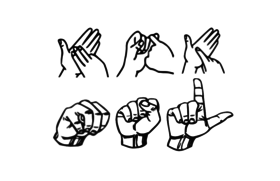Maritime Sign Language
| Maritime Sign Language (MSL) | |
|---|---|
| Langue des Signes Maritime | |
 | |
| Native to | Canada |
| Region | Atlantic Canada |
Native speakers | Unknown |
|
BANZSL
| |
| none | |
| Official status | |
Official language in | none |
Recognised minority language in |
none |
| Language codes | |
| ISO 639-3 |
nsr |
| Glottolog |
mari1381[1] |
.png) | |
Maritime Sign Language (MSL), is a sign language descended from British Sign Language and used in Canada's Atlantic provinces.[2] It was created through the convergence of deaf communities from the Northeastern United States and the United Kingdom immigrating to Canada throughout the 1700s and 1800s.[3] It is unknown the extent to which this language is spoken today, though there are linguistic communities found across the Atlantic provinces. MSL is being supplanted by American Sign Language (ASL) resulting in fewer MSL speakers and a lack of resources (education, interpretation, etc.) for MSL speakers.
The dialect of ASL currently used in the Maritimes exhibits some lexical influence from MSL. ASL is now the main language that is used by the Deaf community in New Brunswick, Nova Scotia and Prince Edward Island. Due to the expansion of ASL, there are fewer than 100 MSL users. [3]
References
- ↑ Hammarström, Harald; Forkel, Robert; Haspelmath, Martin, eds. (2017). "Maritime Sign Language". Glottolog 3.0. Jena, Germany: Max Planck Institute for the Science of Human History.
- ↑ Gordon, Raymond G., Jr. (ed.) (2005). Ethnologue: Languages of the World, Fifteenth edition. Dallas, Tex.: SIL International.
- 1 2 Yoel, Judith. "Canada's Maritime Sign Language". endangeredlanguages. Retrieved 10 February 2017.